Staying cool during hot summers is essential, no matter if you’re working in a stuffy garage, chilling in your small apartment, or using gym equipment in an enclosed basement. Your comfort is the number one priority.
If you need a compact but powerful system to cool a room in your home or property, you might be considering a lightweight air conditioner.
These products come with different types and specifications, which can make it challenging to choose the right one.
Fortunately, we’ve done the hard work by compiling this ultimate buying guide, including the top products, factors to consider, and some tips for setting your budget.
This article introduces you to the world of light and small air conditioners.
At a Glance: Our Top Picks for Lightweight Air Conditioners
- OUR TOP PICK: SereneLife SLACHT128
- RUNNER-UP: Frigidaire FFRA051WAE
- BEST BUDGET OPTION: Black + Decker BPACT08WT
Comparison of the Best Lightweight Air Conditioners
| IMAGE | PRODUCT | |
|---|---|---|
Our Top Pick  |
| View Latest Price → |
 |
| View Latest Price → |
Best Budget Option  |
| View Latest Price → |
 |
| View Latest Price → |
 |
| View Latest Price → |
 |
| View Latest Price → |
 |
| View Latest Price → |
Factors to Consider Before Buying an Air Conditioner
You might want a lightweight AC for different reasons. Still, the goal of our article is to pave your way to a successful purchase. Here are a few factors that you need to keep in mind before going all-in on any choice.
Unit Weight and Size
As we’re talking about lightweight air conditioners, the first consideration should be their size and total weight. You might want one for a small space, a small window, or to alleviate pressure from your old and fragile frames. In any of the mentioned cases, you need to go for the tiniest one that still fits.
ACs are usually pretty heavy, but what makes them that way? Let’s “dismantle” a typical AC and understand what each part does.
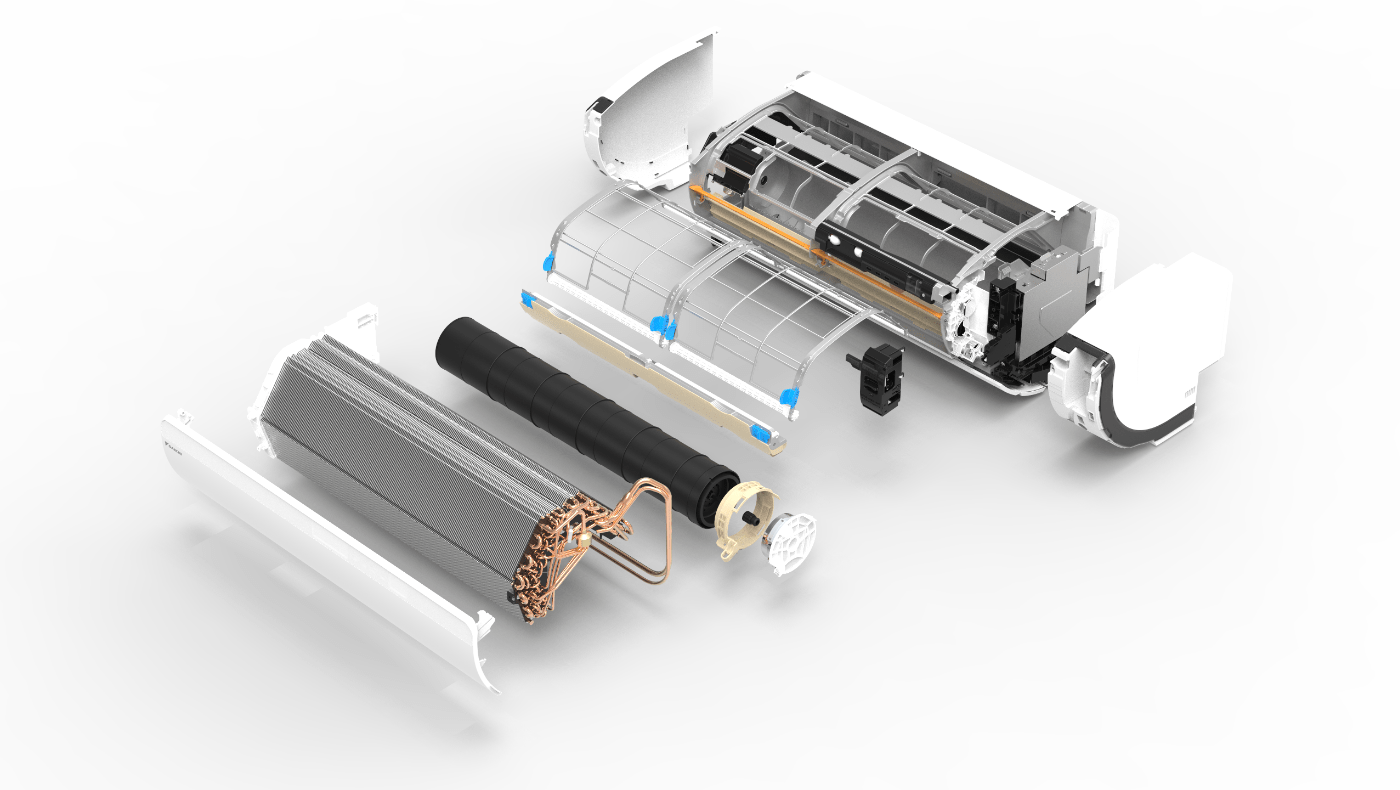
- Metal Components: Any air conditioner is a heavy combination of metal components, a sturdy tank, and compressor parts.
- Liquid Refrigerant: It’s a dense and heavy liquid that flows through the coils and cools the hot air that enters the system.
- Evaporator Coils: The main goal of evaporator coils is to turn the refrigerant into a gas. Due to its temperature conducting properties, it easily passes the refrigerant’s coolness to the air. These are made from copper, which is pretty heavy. Technically, the manufacturers could substitute it with lighter aluminum, but copper is a better heat conductor, making it a more energy-efficient solution for ACs.
- Condenser Coils: These are also heavy, made from copper. Condenser coils’ primary function is to ready the refrigerant for cooling.
- Compressor Coils: These are in the unit to move the refrigerant between the condenser and evaporator coils.
- Smart Tech: Modern ACs also contain some technological components, like sensors, automation chips, and other intelligent elements.
As you may have figured out, the less space the casing has, the less power the unit can have. The reason for this is simple: there would be less space to fit more coils. In a smaller appliance, the copper elements can make up 60% of the total weight. This ratio gets smaller as the units get bigger and heavier.
When it comes to mini-split units, the indoor sections weigh much less: all the coils are outdoors. It’s the “muscle of the operation,” while the indoor unit contains all the tech advancements and is the “brain.”
BTU and Coverage
It’s logical to assume that units with fewer coils will have less capacity. That’s why most lightweight air conditioners can cover 150 to 350 square feet, not more.
British thermal units (BTU) is the power measurement of an AC. The lower the BTU, the smaller space the unit can cover.
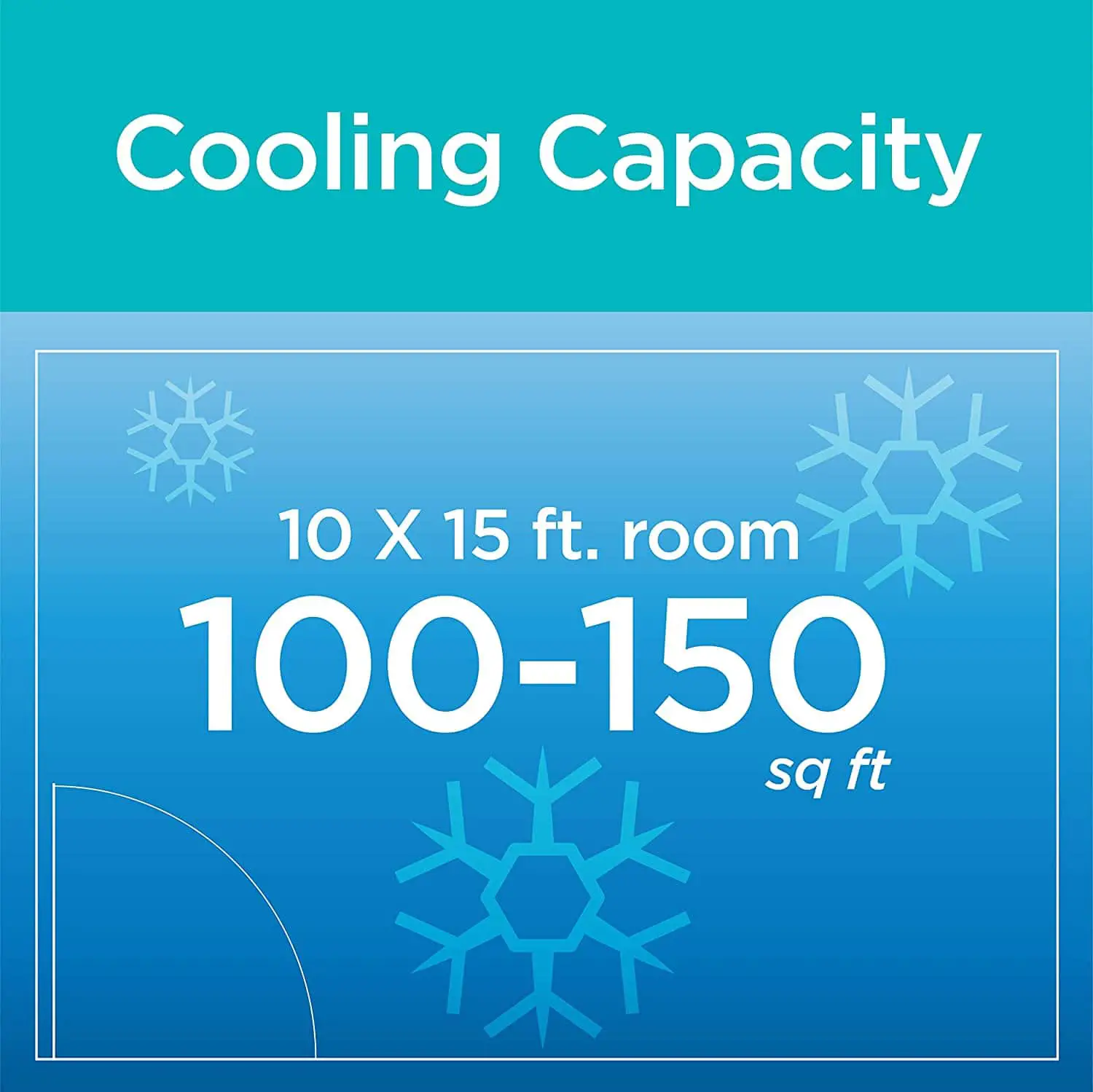
Technology
The more research and development the company puts into building a unit, the more sophisticated it will be. For the best effect, an AC should combine energy-efficient technological solutions with intelligent components.
It might cost more initially, but it will save you money in the long run.
Washable Filter and a Maintenance Indicator
It’s mandatory to check on your unit periodically to see if everything is in order. Changing or cleaning the AC filter at least once a month is essential for the unit’s longevity, maximum efficiency, and, most importantly, indoor air quality.
You’ll get the most of the appliance if you pay attention to how easy it is to clean it. Choosing a unit with self-diagnostics capability and maintenance indication is a nice bonus.
Oscillating Vents
As they move from side to side, these vents make the smaller units more efficient. They allow more consistent airflow and cover maximum space.
Location and Mounting Kit
You’ll need to work out where you’ll be keeping your lightweight air conditioner. Some options include window units, mounted units, or portable ones that sit on the floor. Each has advantages and disadvantages in terms of space, cost, and efficacy.
Ease of installation and the inclusion of a kit to help you fit the unit are also critical considerations. If you opt for a window AC, you’ll want to measure up and be sure that your first-choice product comes with the right elements to help you house it.
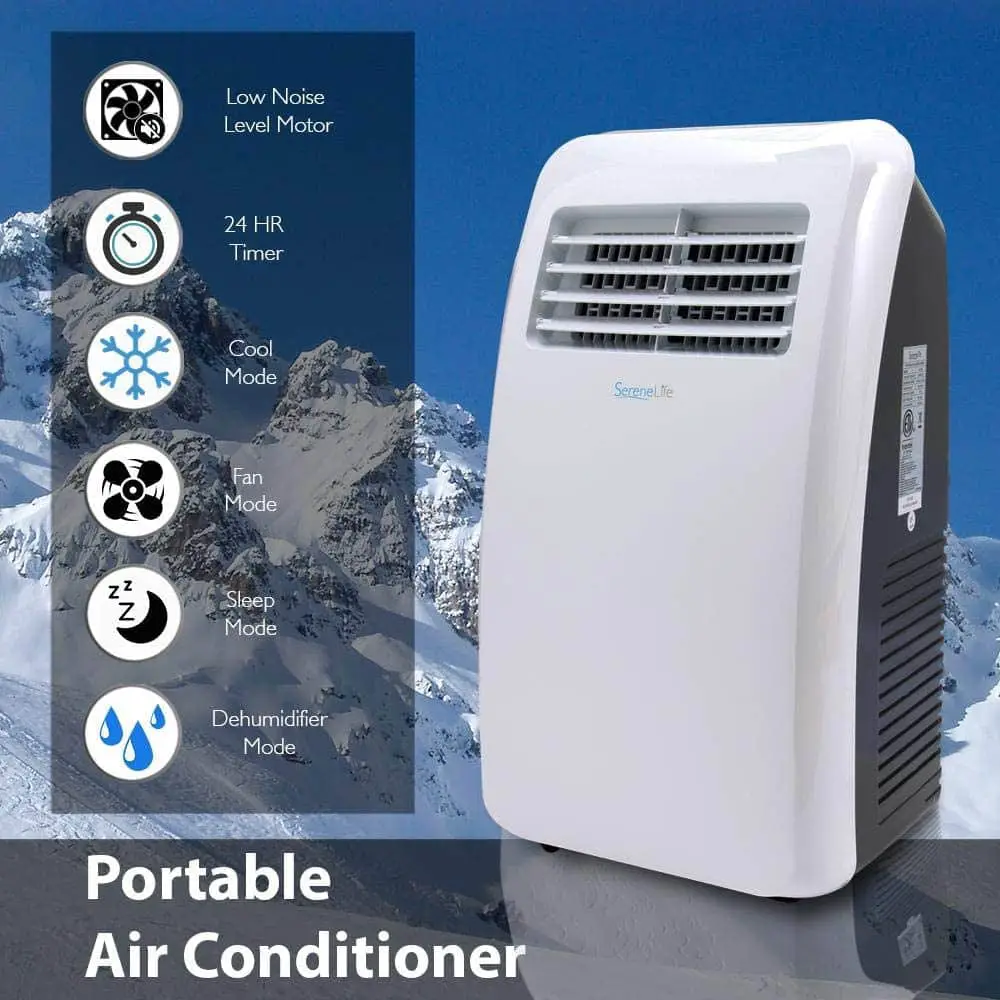
Features and Controls
There are several aspects of an AC unit that can make it more efficient or convenient.
You might want an oscillating vent, which means that air will move around the room more. Another option could be to get a unit with a warning light for when the filter needs changing.
Controlling your air conditioner is equally important. Some units use smart technology to put you completely in control.
Others might offer basic utilities, like a remote control so that you can adjust the temperature from anywhere in the room.
Energy Efficiency
If you’re worried about leaving your AC running for many hours, you could opt for a product with an energy-saving mode or a sleep mode.
It stops the fans from operating when they aren’t needed but will keep the unit going as necessary to maintain the temperature.
It’s possible to work out the energy efficiency of a specific product by dividing the BTU number by the number of watt-hours, which represents power consumption. That gives you the energy efficiency rating or EER; the higher the rating, the better.
Review of the Best Lightweight Air Conditioners
The section below covers top-of-the-class lightweight ACs, proposing each model’s pros and cons and providing thorough descriptions.
Best Overall
SereneLife SLACHT128
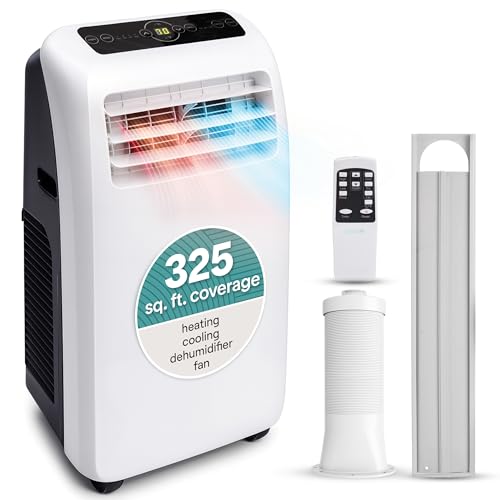
Specifications
BTU: 12,000
Coverage Area: 450 sq.ft.
Dimensions (in): 17.4×13.4×32.1″
Weight: 70.3 lbs.
Decibel Level: 59 dB
We may earn commission from purchases made from our links, at no additional cost to you
Review
While this air conditioner is the heaviest one on our list, it’s a powerful, tiny beast. The unit works at 1350 Watts, with 12,000 BTU of cooling and 7,000 BTU of heating capacity. It’s as powerful as some mini-split ACs.
As for dehumidification, the unit removes moisture at the rate of 1.8 liters per hour.
The box contains the portable AC, a window mount kit with an exhaust hose that can reach up to 10 feet, a remote control, and a setup guide. Although the casing is plastic, it doesn’t look cheap.
Bottom Line
SereneLife SLACHT128 packs a lot of power in its slender body. While it’s heavier and louder than most units on our list, it’s still highly maneuverable due to the rolling wheels. The window kit and the multifunctional remote that come as a package are bonuses for added convenience.
Pros
Remote control
Sleep mode for low noise
Washable and reusable filter
Cooling, heating, fan, and dehumidification
Temperature control and air circulation functionality
Cons
Heavier than most entries on our list
Louder than most units in this category
Runner-up
Frigidaire FFRA051WAE

Specifications
BTU: 5,000
Coverage Area: 150 sq.ft.
Dimensions (in): 15.25x16x12″
Weight: 41.4 lbs.
Decibel Level: 56.5 dB
We may earn commission from purchases made from our links, at no additional cost to you
Review
This Frigidaire window unit is one of the lower-priced models among similar options. At 5,000 BTUs, the AC is light enough for small basements, dormitories, and trailers.
The unit offers two fan speeds and mechanical controls with two cooling modes. It doesn’t include an electronic display or a remote, which might subtract from its practicality. This AC makes around 51 dB noise, which is a reasonable amount for this unit size.
As it’s not too heavy, you can install it quickly and seal the sides with a built-in screen that connects to your window frame.
Bottom Line
This unit is a basic cooling appliance that does the job. Without any fancy functions and buttons, the system cools spaces of up to 150 square feet. If it ever restarts due to a power surge, you can expect the AC to recover to the latest setting right away.
The Frigidaire FFRA051WAE model serves well if you know what to expect from it.
Pros
Easy to install
Remembers the last setting
Two-way air direction control
Side panels close the sides of the window
Energy-efficiency reduces your electricity bill
Cons
Controls are mechanical
No LED or remote control
Best for the Money
Black + Decker BPACT08WT

Specifications
BTU (DOE): 5,000
Coverage Area: 150 sq.ft.
Dimensions (in): 16.5×11.5×26”
Weight: 52.9 lbs.
Decibel Level: 75 dB
We may earn commission from purchases made from our links, at no additional cost to you
Review
Black + Decker BPACT08WT is small and light and comes with a window kit made up of three parts that you have to join and adjust for your window. It’s possible to mount it in horizontal or vertical positions.
The cooling and dehumidification functionality is one of the highlights of this unit. Not only does it remove moisture from the air, but it also doesn’t store it in a tank within the AC and doesn’t need drainage. The water leaves the system due to the advanced, self-evaporating technology.
As you can see, this AC doesn’t need much maintenance. Plus, the filter is easy to remove and clean.
Bottom Line
This model by Black + Decker packs 8,000 BTU in its small casing and makes your space more convenient. This unit is an excellent find for the amount you pay. Connect it to the window kit, take the remote controller with you, and enjoy the drop in room temperature.
Pros
Energy-saving mode
No buckets or drains
Hassle-free installation
Low, medium, and high fan speeds
Cooling, dehumidification, and fan-only settings
Cons
No cons reported
Best Lightweight Window Air Conditioner
Amana AMAP050BW
Specifications
BTU: 5,000
Coverage Area: 150 sq.ft.
Dimensions (in): 15.3x16x12.5”
Weight: 39.7 lbs.
Decibel Level: 55 dB
We may earn commission from purchases made from our links, at no additional cost to you
Review
As customer reviews indicate, the air conditioner performs exactly as it’s supposed to. Although it doesn’t stand out with many functions, it cools an area of 150 square feet without struggling.
The unit is easily installed, as it comes with a kit for that purpose. It doesn’t look stylish or modern; however, it has a decent white color. The rotary controls look like they’re going to turn yellow with time.
Apart from some aesthetic considerations, like the absence of a LED, most of its engineering serves its purpose: it adds efficiency to the unit.
Bottom Line
This unit is an efficient choice and the lightest on our list. Its eight-way-turning louvers help the appliance perform better by reaching all the corners of the room.
While the description doesn’t state if it includes a remote control or not, we can assume it doesn’t. Its controllers on the AC’s front panel are manual, and there’s no LED.
Pros
Removable, washable filter
The lightest unit on our list
Mechanical rotary controls
Two speeds and eight-way directional airflow
Straightforward installation with the included kit
Cons
No LED
No energy-star rating
Best Lightweight Portable Air Conditioner
SereneLife SLPAC8
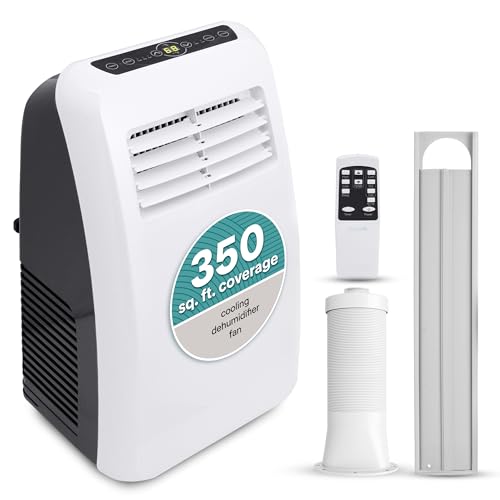
Specifications
BTU: 8,000
Coverage Area: 200 sq.ft.
Dimensions (in): 14.6×13.8×27.2″
Weight: 46.3 lbs.
Decibel Level: 55 dB
We may earn commission from purchases made from our links, at no additional cost to you
Review
This compact AC sits in the corner of your room and moves 290 cubic meters of air into the room per hour. With its 8,000 BTU cooling power and 1.2 liters/hour dehumidification, the unit hits above average in its efficiency.
Although it advertises a low noise motor, the appliance is louder than a few of our picks. The sleek design of the casing and the ease of use help the system make your life more convenient, while its freestanding nature brings a touch of luxury into your house.
Bottom Line
If you want a sleek and compact portable air conditioner for your space, this is one of the best choices available. It will dehumidify and cool around 200 square feet with ease.
The built-in timer makes the unit an intelligent machine that can match your schedules, turning on and off with your desired times.
Pros
LED and remote
Low noise motor (~55 dB)
24-hour timer for easy scheduling
Sleek and lightweight design with wheels
Dehumidification (1.2 liters/hour), cooling, and fan modes
Cons
No cons mentioned
LG LW6017R

Specifications
BTU: 6,000
Coverage Area: 250 sq.ft.
Dimensions (in): 14.38×17.31×11.13″
Weight: 39.6 lbs.
Decibel Level: 52 dB (Low)
We may earn commission from purchases made from our links, at no additional cost to you
Review
At 6,000 BTU, this unit from LG is suitable for cooling rooms up to 260 square feet. It’s a dehumidifier and air conditioner in one product. and comes with a window installation kit, including side panels to secure it tightly.
The upward vents prevent air from directly blowing on you, but the room still stays cool. There are useful features like a clean filter light, energy-saving mode, and a remote to set the speed and temperature. It’s a powerful unit that shouldn’t impact your electric bill much.
Bottom Line
Although the fan can be noisy on lower settings, overall, this air conditioner does the job without too much fuss, even for the installation. It’s efficient and powerful when it comes to cooling and dehumidifying. The remote control and energy-saving features make it convenient and easy to use.
Pros
Dehumidifier
Upward vents
Easy to install
Powerful cooling
Energy-efficient mode
Cons
Some settings can be noisy
Keystone KSTSW10A
Specifications
BTU: 10,000
Coverage Area: 450 sq.ft.
Dimensions (in): 23.5×20.87×14.57″
Weight: 34.9 lbs.
Decibel Level: N/A
We may earn commission from purchases made from our links, at no additional cost to you
Review
If you don’t have double-hung windows, you can still get a window air conditioner. This Keystone unit is an excellent option for those with casement or slider windows. It can cool a medium to large room with 10,000 BTU that covers around 450 square feet.
It has a filter indicator to let you know when it’s time to clean it. In addition to the energy-saving mode, there’s a useful program feature for setting the unit to turn on at certain times, allowing you to come home to an already cool room.
Bottom Line
As with all units, it makes some noise but has a sleep mode that’s quiet and still keeps you cool. It’s a fantastic option for medium-sized rooms in properties with casement windows. It’s a powerful unit that has some handy features, such as programming, that make it convenient to use.
Pros
Dehumidifier
Quiet sleep mode
Programmable timer
Cools medium to large rooms
Option for properties without traditional windows
Cons
Not suitable for standard windows
Midea MAW05M1BWT

Specifications
BTU: 5,000
Coverage Area: 150 sq.ft.
Dimensions (in): 15.98×13.19×12.05″
Weight: 41.4 lbs.
Decibel Level: 57 dB
We may earn commission from purchases made from our links, at no additional cost to you
Review
This compact unit makes installation a breeze. It’s small and light enough to carry and install on your own, and the instructions are clear. Once up and running, it also cools a room down quite quickly. It’s 5,000 BTU, so meant for small rooms of 150 square feet.
If you have high or low windows, then the fact that the vents only move from side to side might be an issue. It doesn’t have a huge variety of settings. However, you’ll find that it’s energy-efficient and does a good job in a well-insulated room, even on low mode.
Bottom Line
It’s a basic unit that’ll fit most windows and is easy for one person to install. It’s designed for small rooms and does a satisfactory job of cooling them quickly. There’s not much in the way of features, and the vents only move in two directions, although that’s reflected in the price.
Pros
Compact
Cools quickly
Energy efficient
Easy to install
Ideal for small spaces
Cons
No remote control
Fan only adjusts from side to side
SereneLife SLPAC105W

Specifications
BTU (DOE): 6,000
Coverage Area: 300 sq.ft.
Dimensions (in): 27.6×12.8×11.6″
Weight: 55 lbs.
Decibel Level: 57 dB
We may earn commission from purchases made from our links, at no additional cost to you
Review
If you’re looking for a lightweight floor unit that can handle a medium-sized room, this unit fits the bill. It’s 10,000 BTU and can cover a room that’s 300 square feet. The wheels make it easy to move around, and the kit comes with a vent for installation in your window.
There are some useful features, such as a display showing the temperature and Wi-Fi controls to turn the unit on before you arrive home. However, there aren’t instructions on how to use those features. On the other hand, setting up the unit is fast and straightforward.
Bottom Line
This free-standing, lightweight air conditioner provides cooling and dehumidifying. It’s ideal for medium-sized rooms where you don’t want a window unit. The remote and Wi-Fi controls are convenient for managing the temperature and making your room cool before you arrive. It comes in an attractive casing and doesn’t take up too much space.
Pros
Dehumidifier
Wi-Fi control
Setup is straightforward
Easy to move on wheels
Remote control and temperature display
Cons
Limited instructions
hOmeLabs HME020003N

Specifications
BTU: 5,000
Coverage Area: 150 sq.ft.
Dimensions (in): 16×15.4×12″
Weight: 36.5 lbs.
Decibel Level: N/A
We may earn commission from purchases made from our links, at no additional cost to you
Review
This compact but powerful unit is a window-mounted 5,000 BTU air conditioner. It’s designed for spaces of around 150 square feet, so it would work well in bedrooms, RVs, or offices. One of the main advantages is that it can bring the temperature down quickly.
It doesn’t have bells and whistles, just two dials on the unit to control the temperature and to switch between the speeds for fan and air conditioning mode. It’s so lightweight that installation is easy, even as a one-person job, plus the size means it should fit most windows.
Bottom Line
If you need something small and lightweight to cool a small room, this unit is a great option. It’s simple in its controls, but you’ll feel the temperature change within a few minutes. Installation is easy as the unit is light and comes with everything you need.
Pros
Compact
Fast cooling
Easy to install
Simple and reliable
Ideal for small spaces
Cons
No remote for controls
When Would a Lightweight AC Come in Handy?
While lightweight ACs are appropriate for various conditions, some spaces require more precise weight and size solutions. Versatility is another reason for choosing a more compact unit. Below, we’ve described a few situations where these appliances best work their magic.
Space and Size Limits
This is one of the most obvious reasons to choose a smaller and lighter AC. Small apartments, trailers, food trucks, basements, and garages are where a portable unit or a small-window system might be handy.
First of all, you don’t need an awful lot of BTUs to cool a smaller area. Second, you might not have much space to install a larger unit either. If you’re going for a window AC, the frames might be narrower and more fragile in all these cases.
Choose a lightweight appliance, and your life will become that much cooler.
Where the Wall-Mounted Version Won’t Cut It
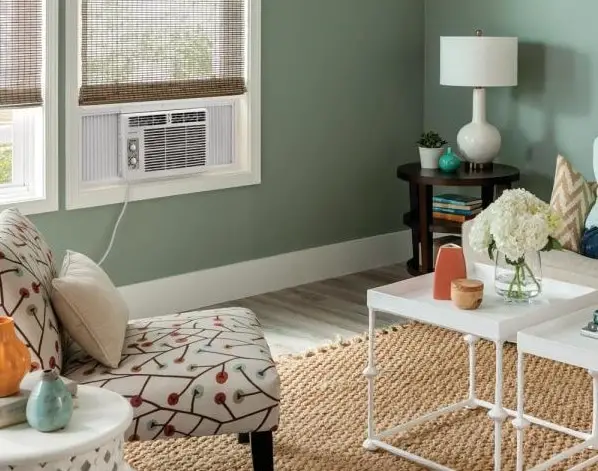
Although the indoor sections of wall-mounted ACs are lighter than window or portable ones, there are situations where you don’t want the permanence or don’t have walls, to begin with.
Summer patios, temporary buildings, and field tents are a few examples of areas that might require a lightweight AC.
User’s Physical Limitations
Light, compact units are ideal for people who can’t deal with bulky appliances and need portability and convenience, all in one package.
These options have effortless maintenance with removable filters and easy drainage, accessible for elderly individuals and people with disabilities.
Where Would a Lightweight Air Conditioner Come in Handy?
There are several locations where you could use a lightweight air conditioner. If central air doesn’t reach a space, or if you need to keep one area particularly cool, you might consider one of these units.
Attic Rooms
Heat often gets trapped at the top of the house, which means that even in moderate climates you might need help to stay cool. Also, your existing system might not be doing enough to reach the uppermost floor. A lightweight unit is an excellent option for these spaces, as it’s easy to carry up the stairs and install.
Bedrooms and Offices
Rooms like offices and bedrooms are where you require the most comfort. If you spend all day in one room working or want to be cool enough to sleep at night, a lightweight unit is a practical option. It provides cooling for smaller spaces but is powerful enough to bring the temperature down quickly.
RVs and Workspaces
If you have an RV, a workshop, or a shed, you’ll still want to enjoy a comfortable temperature. It can be challenging to install a larger AC system, which is why lightweight units are a fantastic option. They’re easy to install and don’t require ductwork. They also work efficiently in smaller spaces.
Window vs Portable Lightweight Air Conditioners
If you’re searching for a small and light unit, your choice is between the mis. While they are similar in some ways, you can read on to learn which is a better pick for you.
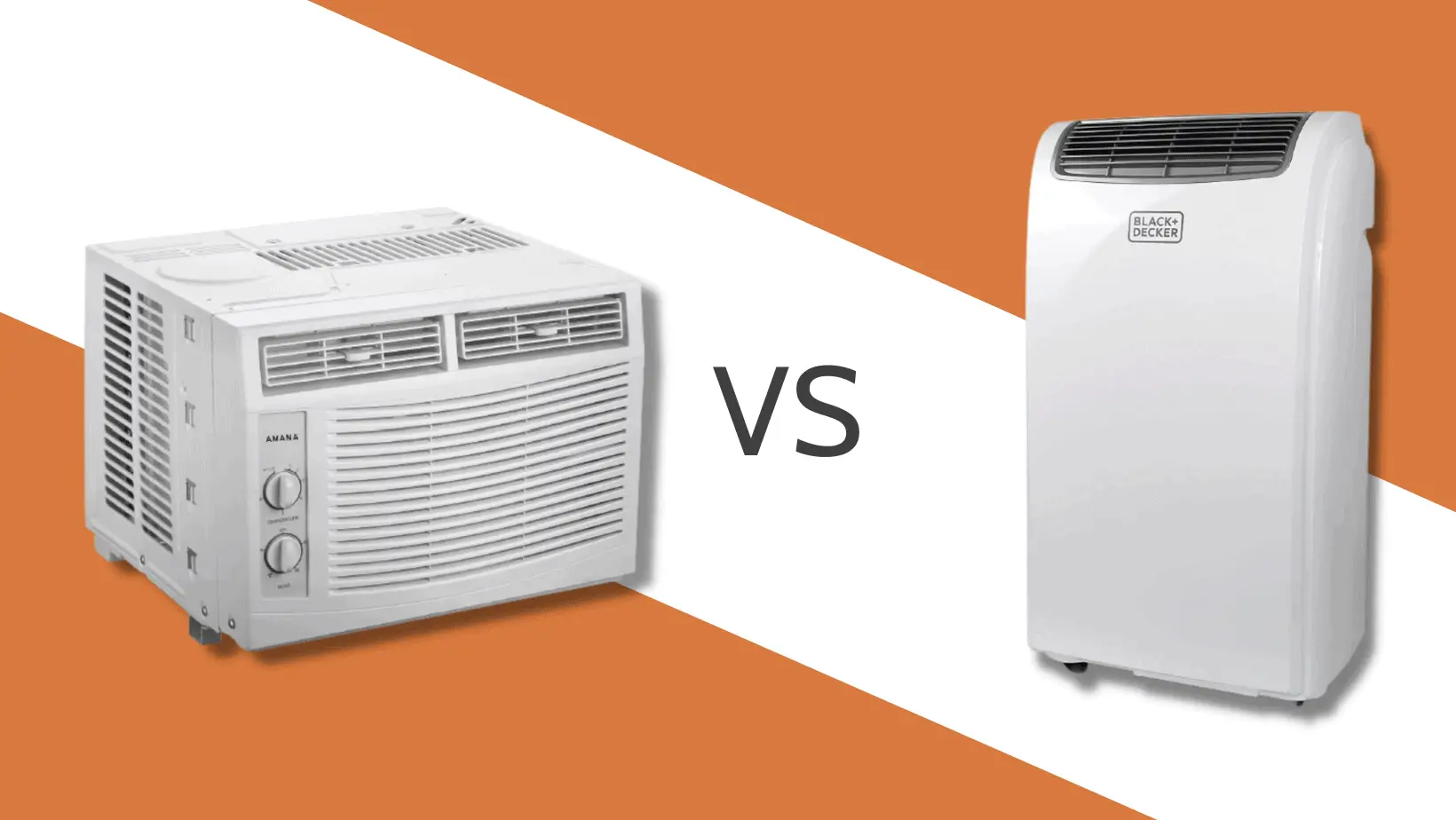
Efficiency
Experiments show that window units if installed correctly, are more energy-efficient than portable ACs. Any aircon generates heat during operation. Most of the window unit’s heat-producing part is outside.
The portable variety has all its components in your space. Plus, the longer the exhaust hose, the lower the unit’s efficiency.
Budget
Most window ACs are initially cheaper than portable ones. The latter also loses at the energy-efficiency front. Thus, if you’re looking for a budget-friendly solution, look around for a window air conditioner.
One Room at a Time
While window ACs work for only one room, you can use the portables in several. However, depending on where and how you mount it, the latter might become a stationary appliance.
The Issue of Choice
In the case of both units, you lose something. Window ACs block the pane — sometimes forever, as these can double as heaters.
Portable ones take up floor space and have awkward exhaust hoses dangling from a window or ceiling (or other venting positions).
The Issue of Taste
While both units can be bulky and clunky, some models look better in both categories. The only consideration here is that the hoses on portable units are usually quite ugly to look at.
Top Brands in the Lightweight Air Conditioner Space
Research and development in air conditioner manufacturing are of utmost importance. Older brands have had more time to develop technologies and shape their approach to manufacturing. In most cases, market-leading brands have more experience with common issues.
Let’s see which one excels at lightweight AC manufacturing.
Frigidaire
Frigidaire is an American subsidiary of the European Electrolux company that has been around for decades. At first, it was famous for its refrigerators. Now, it also manufactures lightweight, portable, whole-house, and commercial HVAC solutions.

LG
This is one of those brands that put a country on the international radar. LG has been around since the end of the 1950s and counts more than 72,600 employees worldwide.
The company is best known for its home and entertainment appliances, but it’s also huge on automotive parts manufacturing in Asia.
As you might know, the company produces TV sets, mobile devices (smartphones, smartwatches, and tablets), and home appliances (washers, vacuum cleaners, and microwave ovens).
Air conditioner variety includes mini-split, window, and portable units. It excels in infusing the appliances with smart systems.
Honeywell
Honeywell is a company based in North Carolina, USA. It’s well-known for various products, like security safes, thermostats, heaters, and paper shredders.
The brand also has branches that work on aircraft and missile manufacturing under other names.
The company is best known for its sleek and light air conditioners that function for decades.
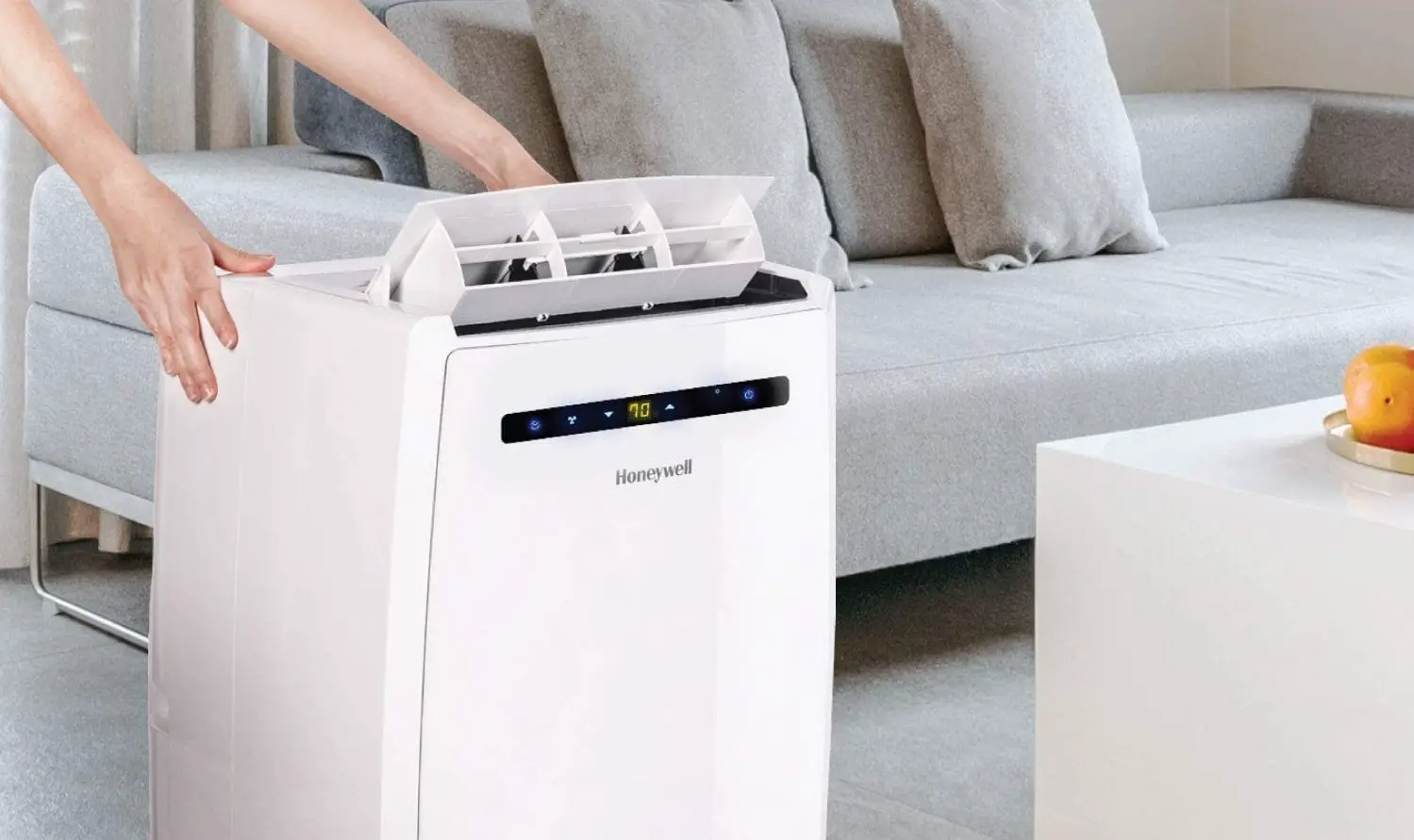
hOmeLabs
This household appliances retailer is part of a larger company called Mohawk Group Holdings. It’s based in New York, although it’s a global business with offices in Canada, China, and the Philippines.
The focus is on appliances, including air conditioners, purifiers, and dehumidifiers. The company also sells refrigerators and kitchen appliances, such as freezers, refrigerators, and air fryers. It’s a small firm that’s making a name for itself in this specific industry.
Keystone
Now we come to a specialist in HVAC (heating, ventilation, and cooling). Keystone focuses solely on solutions for temperature regulation and provides a range of products and services for home heating and cooling.
It’s an international company, although you’ll most likely find its products through third-party retailers, such as Amazon, Home Depot, and Walmart. Its products include air conditioners, dehumidifiers, fans, evaporative coolers, and refrigeration.
Benefits of a Lightweight Air Conditioner
Light and small air conditioners have plenty of advantages if you know what to search for. Below are a few of them, explained.
Portable and Convenient
As we’ve already mentioned, the lightweight units are easier to deal with and maneuver. If you’re choosing a portable AC, cooling all your house with one appliance is realistic. If you’re searching for a window unit, you’re only going to be cooling one room.
Almost No Installation
Yes, you might have to know how to use a screwdriver so that you can attach a window kit or secure a window unit, but that’s about it.
Installing these lightweight appliances is a DIY job for one handy person. You just need to follow simple instructions.
With portable units, you don’t even need to break a sweat.
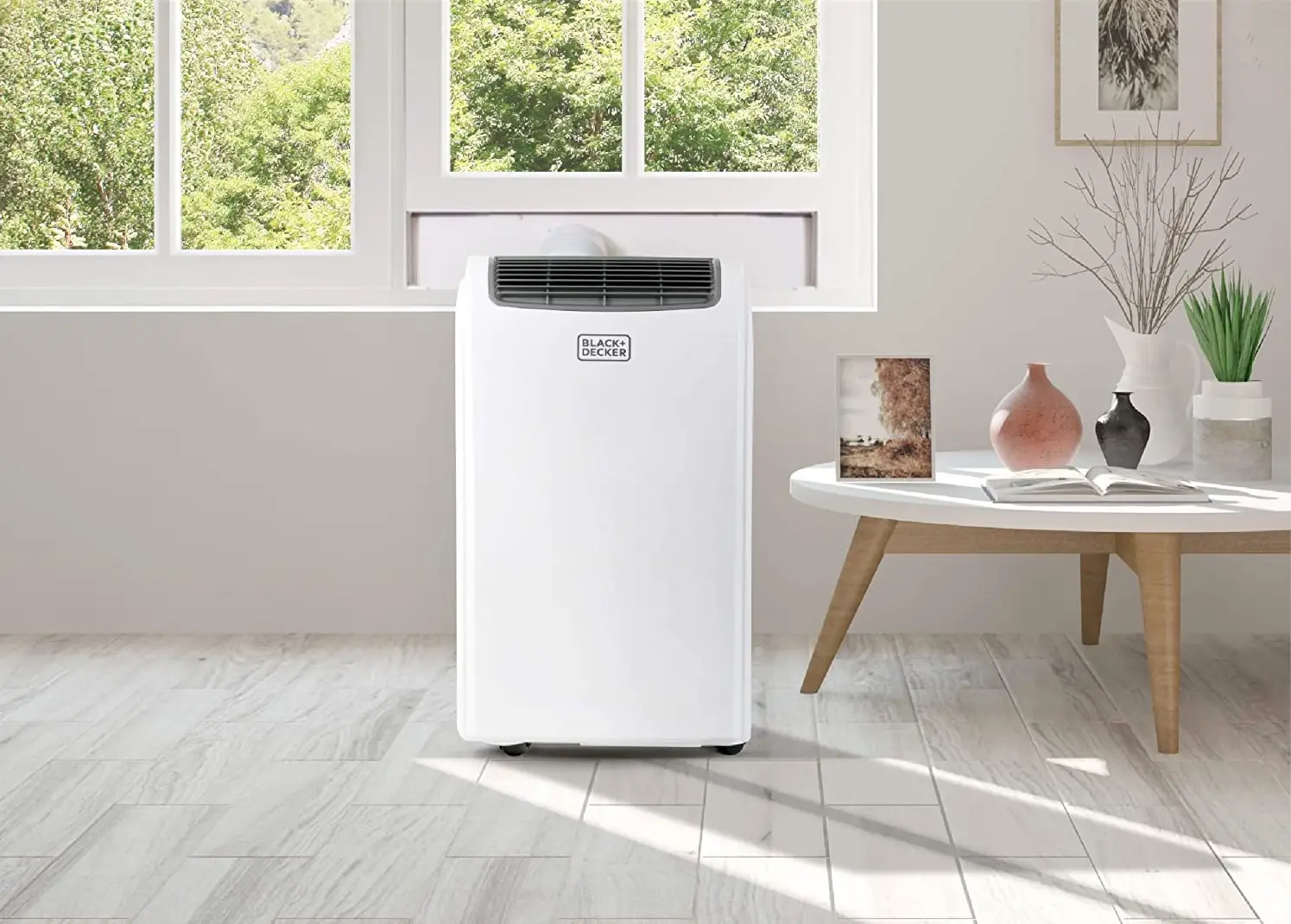
Fewer Restrictions, More Comfort
If you’re renting your apartment, or the building management code won’t allow permanent units, the lightweight, portable ones can be a saving grace for you. Take your AC when you move or enjoy the cool without getting your claws out with the building manager.
Dehumidification and Other Functions
Cooling isn’t the only function lightweight ACs accomplish. Most of them have three or four modes:
- Cooling
- Heating
- Dehumidification
- Fan only
As all ACs include an air filter, they also purify the air. Most advanced models also have ionization functionality. The unit releases particles, which neutralize the dust and harmful elements in the air.
Price Points of Lightweight Air Conditioner
As with many appliances, there are different price brackets for the range of products. Sometimes that can be an easy way to spot a product that meets your needs in terms of budget, and it can be a good indicator of features and specifications.
$150 – $250
The lower price range typically applies to compact units. They’re small in size but also power, so you can expect these products to be 5,000 BTU and suitable for cooling 150 square foot spaces.
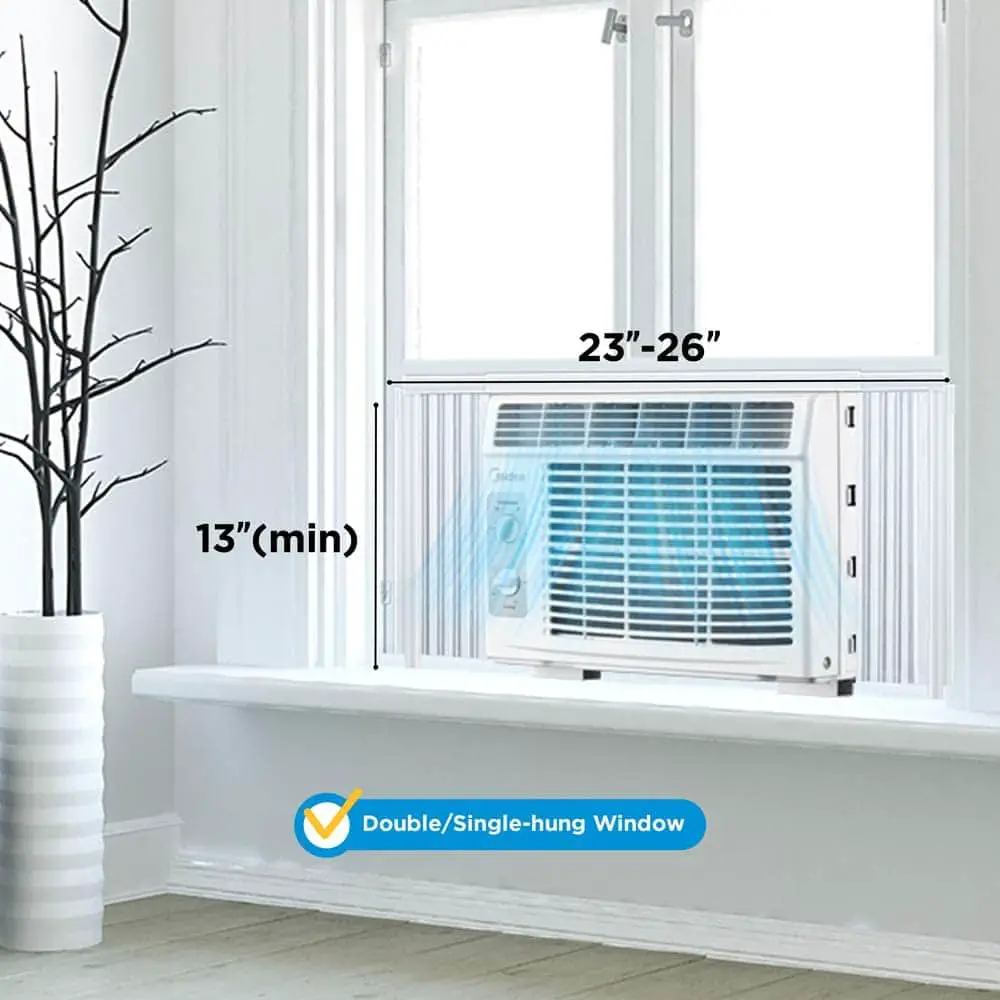
It’s common for units at this lower price to have basic controls, for example, a range of two fan settings controlled by dials. These products don’t usually have remote controls, energy-saving modes, or other functions like dehumidifying.
$250 – $350
The middle price range is where you’ll find quite a lot of lightweight air conditioners that are standard size. You’ll see portable and window units in this bracket. Typically, portable products will be high-end with Wi-Fi controls and remotes.
Most options in this price bracket provide cooling and dehumidifying capabilities. They’ll often be mid-sized units of around 6,000 to 10,000 BTU, covering rooms of 260 to 300 square feet.
$400+
The higher price range includes units that are 10,000 BTU or more. They’re more powerful and can cool medium to large-sized rooms. They often come with a wide range of features, such as sleep mode, energy saving, remote controls, and several different settings for fan and cooling speed.
Many products are multi-purpose, as they offer cooling and dehumidifying. You’ll also find specialist design units in this category. For example, air conditioners for non-standard fittings like casement windows are often over $400.
Who Should Not Buy a Lightweight Air Conditioner?
While these products undoubtedly have some advantages, they aren’t necessarily right for everyone. Here are a few situations where purchasing a lightweight AC might not be your best option.
As a Whole Property Solution
If you’re looking to keep every room in your house or property cool, then a lightweight air conditioner could be an expensive and inefficient option. You’ll need units in every room and have to start them running to get each part of your home chilled when you want to use it.
For larger properties, you’ll want a more substantial and coordinated system such as central air or an evaporative cooler and ductwork to control the temperature.
Insufficient Space for Installation
Lightweight air conditioners are typically portable or window units. Either way, you’ll need to install the product or its vent in one of your windows.
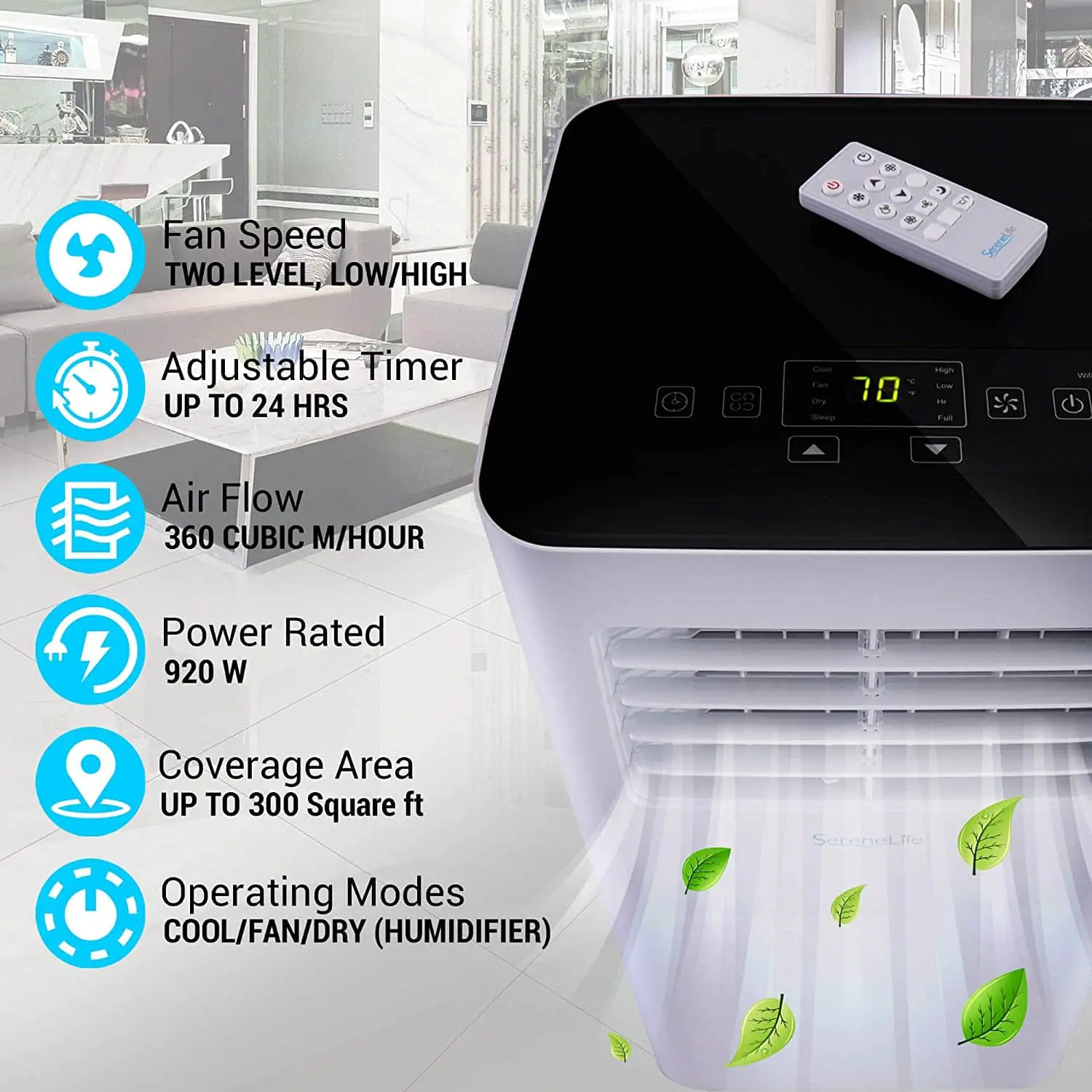
If you don’t have a space suitable for that, you might want to consider having a professional install a wall-mounted split system instead.
You can get support for installing lightweight units, but most are DIY jobs. If you don’t feel comfortable making sure it fits your window just right, and there’s another cooling option available, it’s worth taking that into account.
If You Desire Both Heating and Cooling
If you live in a moderate climate and would like an all-in-one system, a lightweight air conditioner won’t meet your needs. They usually only provide cooling and dehumidifying. On the other hand, heat pumps and wall-mounted split-systems can generally be reversed in winter to help you maintain a comfortable temperature.
Conclusion
Choosing a lightweight AC doesn’t need to be a hassle. Once you define your needs, the process is as easy as choosing a pair of shoes. If it fits your size, weight, coverage, and energy-efficiency specifications, the appliance will be looking at you from our list.
People Also Ask
While we’ve talked about brands, advantages, and specific models of lightweight units, we’ve left some questions unanswered. Read below to get more answers about the safety and weight of this AC category.
Depending on their BTU, the ACs weigh from 39lbs to 130lbs. Although there are outliers, an average 10,000 BTU unit weighs about 70lbs:
Window: 64lbs
Portable: 66lbs
Wall-mounted: 26lbs
Whole house: 179lbs
Lightweight window air conditioners are usually made to be easy to carry and install. However, they still need to contain the equipment to cool your room adequately. Most products weigh between 30 and 45 pounds.
All electronics are prone to safety hazards. When comparing units in lightweight and usual categories, they pose similar safety concerns.
If we’re talking about a lighter window unit on an older, more fragile window frame, it’s safer than a heavier one in the same spot. However, if you mount both properly with solid brackets, it might never fall off, even after a few decades.
Lighter portable units are less likely to strain your back if you try to move them. But again, all portable ACs have wheels or some other kind of a fix to make them easier to roll into another room.
Despite all of the fantastic attributes of a lightweight air conditioner, there are some compromises. These can include control and function, which don’t always compare with larger systems. Noise is another issue, as everything, including the fan and coolant, is located inside one unit.
Air conditioners use coils, namely an evaporator and a condenser, to cool the air. The refrigerant needs to be moved between the coils to heat up and cool down to produce the cooling effect. Combine this space with the need for fans, filters, electrical components, and sometimes dehumidifying capacity, and it all adds up to a heavy unit.
